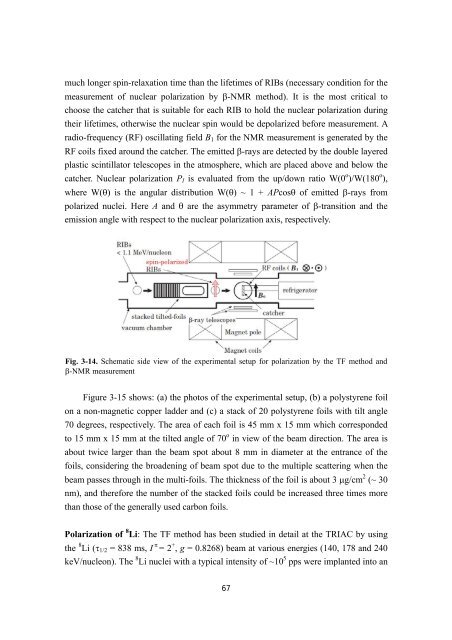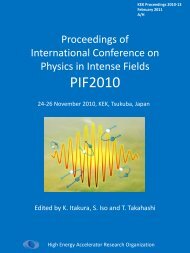TRIAC Progress Report - KEK
TRIAC Progress Report - KEK
TRIAC Progress Report - KEK
You also want an ePaper? Increase the reach of your titles
YUMPU automatically turns print PDFs into web optimized ePapers that Google loves.
much longer spin-relaxation time than the lifetimes of RIBs (necessary condition for the<br />
measurement of nuclear polarization by β-NMR method). It is the most critical to<br />
choose the catcher that is suitable for each RIB to hold the nuclear polarization during<br />
their lifetimes, otherwise the nuclear spin would be depolarized before measurement. A<br />
radio-frequency (RF) oscillating field B1 for the NMR measurement is generated by the<br />
RF coils fixed around the catcher. The emitted β-rays are detected by the double layered<br />
plastic scintillator telescopes in the atmosphere, which are placed above and below the<br />
catcher. Nuclear polarization PI is evaluated from the up/down ratio W(0 o )/W(180 o ),<br />
where W(θ) is the angular distribution W(θ) ~ 1 + APcosθ of emitted β-rays from<br />
polarized nuclei. Here A and θ are the asymmetry parameter of β-transition and the<br />
emission angle with respect to the nuclear polarization axis, respectively.<br />
Fig. 3-14. Schematic side view of the experimental setup for polarization by the TF method and<br />
β-NMR measurement<br />
Figure 3-15 shows: (a) the photos of the experimental setup, (b) a polystyrene foil<br />
on a non-magnetic copper ladder and (c) a stack of 20 polystyrene foils with tilt angle<br />
70 degrees, respectively. The area of each foil is 45 mm x 15 mm which corresponded<br />
to 15 mm x 15 mm at the tilted angle of 70 o in view of the beam direction. The area is<br />
about twice larger than the beam spot about 8 mm in diameter at the entrance of the<br />
foils, considering the broadening of beam spot due to the multiple scattering when the<br />
beam passes through in the multi-foils. The thickness of the foil is about 3 µg/cm 2 (~ 30<br />
nm), and therefore the number of the stacked foils could be increased three times more<br />
than those of the generally used carbon foils.<br />
Polarization of 8 Li: The TF method has been studied in detail at the <strong>TRIAC</strong> by using<br />
the 8 Li (τ1/2 = 838 ms, I π = 2 + , g = 0.8268) beam at various energies (140, 178 and 240<br />
keV/nucleon). The 8 Li nuclei with a typical intensity of ~10 5 pps were implanted into an<br />
67













